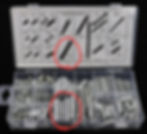SST LUBECUBE Review | Fogless Coolant Sprayer That's Cheaper Than FogBuster, but is it as good?
- Daniel Soulbuilt
- Nov 14, 2023
- 7 min read
Updated: Jun 27, 2024
I've been eyeing the Fogbuster system for years for times/equipment where I can't use flood coolant, but I just can't swallow paying several hundred dollars for a water filter housing, some tubing, and a small block of metal.
Along comes SST, and finally makes a similar fogless flood coolant system, the SST Lube Cube, that may even have some improvements.
▼ WHERE TO BUY
IS LUBECUBE A COPY OF FOGBUSTER?
Yes, but the original Fogbuster patent was filed in 1995 and has since expired, so anyone can make and sell this design.

WHICH MACHINES TESTED ON?
I purchased the SST Lube Cube Fogless coolant sprayer primarily for use on the HAAS TM-1 CNC milling machine. This is currently an open machine, and until I enclose it, I don't want to use flood coolant, because it will be too messy.
It could also be useful in situations where an air blast works better than flood coolant, although the strong air blast needs to be on a separate nozzle, and it may create more mist if it hits the coolant stream.
I was planning to also use it on the band saw (no coolant collection pan) and cold saw (with coolant collection), but then I realized that those don't really need the airstream aspect, so using a simple peristaltic pump will be effective for dripping coolant on the blade.
WHICH MATERIALS TESTED?
The SST Lube Cube has mostly been used on aluminum, 6061 and some gummier varieties that love to clog the end mills. Even the very nice, highly polished YG-1 Alupower end mills can clog when used without coolant on the softer aluminum (like machining aluminum t-slot extrusions). It is essential for machining aluminum without flood coolant, otherwise, the tool will eventually get gummed up with aluminum.
It has also been used for peck drilling high carbon steel to keep the hole cool and prevent material hardening.
HOW WELL DOES IT WORK?
As long as the coolant is flowing at the correct rate it works very well to keep the tool cool and lubricated. Initially, I had some issues where I would set the flow and then the flow would change and decrease. If I wiggled the adjustment knob axially (there's no noticeable play), or the machine vibrated enough the flow would start up again, and then after a while, it would decrease sometimes all the way to no flow. I spoke to Juan the owner of SST (who was very pleasant and helpful) about this issue and he found it strange, and the only thing that he could think of is that there is a blockage in the needle valve caused by some debris or the coolant itself. I decided to back-flush it with water to see if I could clear out anything that was causing a clog. That actually seems to have resolved the issue and now the coolant flow appears to remain constant and it doesn't change over time. I don't know if I introduced the debris while assembling it or into the coolant (there is a filter on the coolant input), but whatever was there was causing issues.
So now that that is solved it works really well. I have never used a fogbuster system but I would expect that this system is on par. The adjustment knob is much larger which I've heard makes it easier to fine-tune the flow. I usually only turn the adjustment knob about 1/8 to 1/4 of a turn.
Air Pressure
I set the air pressure to between 10-15 PSI. That's enough air pressure to spray the coolant onto the tool and cut, but it's not really enough to clear chips. Increasing the air pressure causes the coolant to turn into mist when it hits the tool/cut. Probably need to use a separate air blast to clear chips. I've read that a pulsed air blast is very effective for chip clearing, and uses less air than a continuous air blast.
Which Coolant To Use and How Much?
Many coolants will work (except for alcohol or alcohol-based because it will damage the reservoir). A water-soluble coolant will work best. I'm using TRIM 690XT, and it is working well and easy to clean up.
I diluted the coolant in water to about 10% coolant to 90% water. TRIM recommends 5-10%, so I chose the higher range due to the improved rust prevention, and better lubrication, and since the consumption is relatively low. I will experiment with a lower 5% coolant because then I could double the flow rate, which may improve the cooling, and easier to visualize the flow rate.
Coolant Consumption
When set between 1/8 and 1/4 turn it uses very little coolant. It appears to be about 1 drop per 2 seconds. A full reservoir of coolant lasted for several days of machining. The coolant barely makes it to the table before the water evaporates, leaving behind only the oily residue (which easily washes off the part with water).
Part Cleanup
Cleanup depends on the coolant you are using. The TRIM 690XT leaves an oily film on the parts, but it is easily removed by rinsing with water.
PROS
It's less than half the cost of a FogBuster. I was planning to DIY one, but the SST solution was cheaper if I took into account time spent making it.
Works very well for CNC milling (only thing I've tested it with so far)
Large adjustment knob for fine-tuning flow
A strong magnet base to hold to spindle
The 2 tubes are bonded together, making it easier to manage.
Nicely constructed parts
IMPROVEMENTS THAT COULD BE MADE
WEIGHT ON PICKUP TUBING INSIDE THE RESERVOIR
The pickup tubing inside the reservoir has a filter on the end but it's not heavy enough to keep the tubing down at the bottom of the reservoir. The new tubing that was included in my kit had a very strong curl to it that wanted to pull the tip of the tubing up to the top of the reservoir and therefore it would not have picked up any coolant. I had to add a nut onto the end of the coolant line to make it heavy enough to stay at the bottom. Once that coolant tubing relaxes a little bit it'll probably stay down there just fine.
TUBING STRAIN RELIEF TO PREVENT KINKING
Adding a strain relief to the tube ends where they connect. When the LubeCube was setup in a position that sharply bent the tubes, the tubes would eventually collapse and kink at the barbed connector. Adding a spring from a Harbor Freight spring assortment solved the problem, even when the tubes get stretched to their limit.
Original tubing without the spring. It's not kinked here, but it didn't take much to kink it.

Spring added over the tubing. Also pushed it over the barbed fitting.

Closeup of spring over tubing and barbed fitting.

BACKFLOW PREVENTER CHECK VALVE
NOTE: Juan says that they will be including check valves soon.
The reservoir must be below the Lube Cube at all times otherwise the coolant will flow out of the Lube Cube due to siphoning and gravity. The downside to that is that the coolant tends to backflow into the reservoir when it is turned off. Space? A check valve is needed in line of the coolant tubing to prevent the coolant from back flowing. The check valve needs to have a very low cracking pressure, otherwise the coolant pressure won't be able to overcome the air pressure inside the mixing head.
UPDATE! SST now includes a check valve with the Lube Cube kit.

SOLENOID AIR VALVE
NOTE: Juan says that they will be offering solenoid air valves in the future.
In order to be able to automatically turn the Lube Cube coolant on and off using the CNC program and air solenoid needs to be added to the incoming pressurized air. The solenoid valve voltage needs to match the coolant output voltage of the CNC machine. In the case of a HAAS CNC milling machine that voltage which normally powers the coolant pump is 220 volts and since it's coming from three phase you can't just take one leg of that 220 to run a single phase 110 volt solenoid valve because there's no neutral in the connector on the CNC. Check this other post on how to install a solenoid air valve on a HAAS CNC mill.
There are also 12V, 24V, 110V, and 220V solenoids available.
UPDATE! SST now includes a solenoid valve with the kit. You have the option of a 110V or 12V solenoid valve.

RESERVOIR
NOTE: Juan says that they are investigating alternate canisters, but they are all opaque.
The reservoir canister can not be used with alcohol. Alcohol will make it crack. I'm not comfortable pressurizing (even at only 10-20psi) a canister that could crack and explode due to chemical exposure, even if I never use it with alcohol. I would like to put a metal cage around it to contain an explosion. Hopefully it never does, but I don't want to risk it.
UPDATE! SST now offers the option of a polycarbonate (standard clear reservoir) or polypropylene (opaque reservoir).
ADJUSTABLE ARM IMPROVEMENT USING THRUST BEARING
The adjustable arm that comes with the kit is of the same quality as inexpensive dial indicator arms. The addition of a very inexpensive thrust bearing makes the arm as nice as a $100+ NOGA brand arm. It makes the arm backdrivable without losing tightness and allows the tightness to be fine-tuned to make it easier to adjust the arm. Watch this video to see how to add that thrust bearing.
▼ WHERE TO BUY THRUST BEARINGS
DREAM IMPROVEMENTS (Not realistic due to additional cost)
The following are improvements that are unrealistic to add on for the current cost. They would significantly increase the cost of the system but also improve its usability.
One of the downsides to using air pressure, is that it's difficult to control the coolant flow rate, and it's not repeatable. Repeatability is important if the cutting job must be consistently reproduced in a manufacturing environment. The air pressure and knob control are really only suited for prototyping work where the operator is able to fine-tune the coolant flow. With a precisely metered flow pump, the flow rate setting could be saved as part of the job setup, such that it can be easily set again the next time the job is run.
DISCLAIMER:
The products shown here were purchased by me with the intent to use them. I did not receive any free items, and I am not being paid or compensated for this review. The video, description, and comments may contain affiliate links. If you click on a link, I may receive a commission. Money earned helps to support my channel and bring you more informative videos about engineering, crafting, and DIY.





















